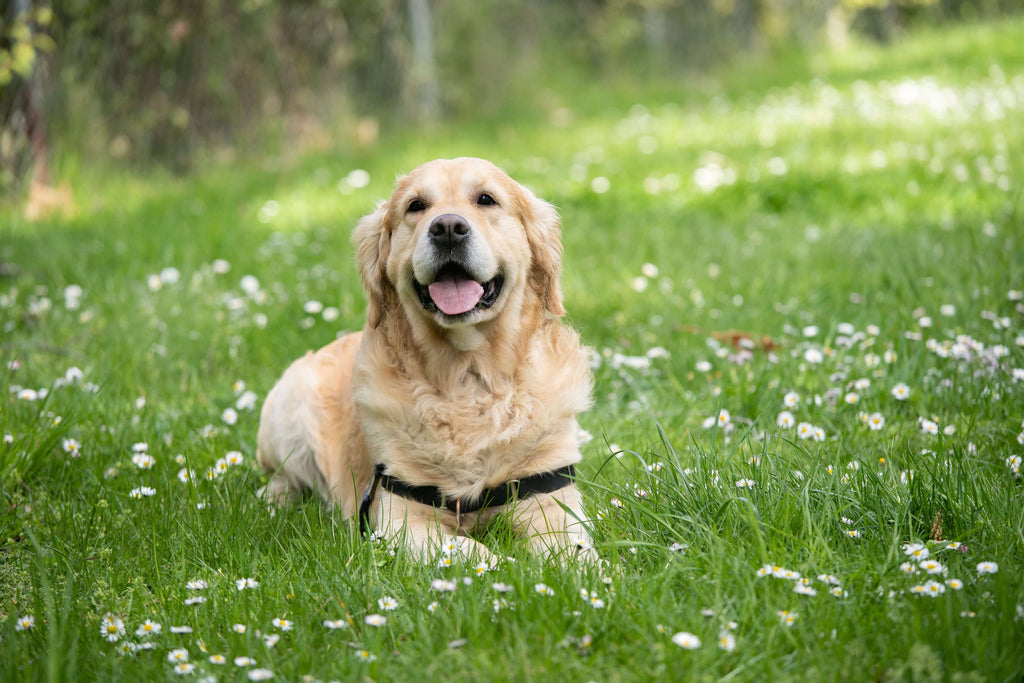
Hip Dysplasia in Dogs: What is it and What can you do about it?
We all want our pup to live the best and fullest life possible. Part of doing so is educating yourself on possible health ailments to which they may be susceptible. One of the most common orthopedic conditions of large breed dogs is hip dysplasia. If you have or are considering a large breed dog (typically over 50-lbs or 25-kg), you need to know and understand this disease. Any size or breed of dog can have hip dysplasia, but, in general terms, the larger the dog, the greater the risk of developing hip dysplasia.
Let's look at the causes, symptoms and possible treatment options.
What is hip dysplasia?
Hip dysplasia is a deformity of the hip that occurs during growth. The hip joint is a "ball-and-socket" joint. During a puppy’s rapid growth phase, usually around six to 18 months of age, both the "ball" (the head of the femur or “thigh bone”) and the "socket" in the pelvis (acetabulum) must grow at equal rates. In hip dysplasia, this uniform growth during puppyhood fails to occur. The result is laxity or looseness of the hip’s ball-and-socket joint followed by degenerative joint disease (DJD) or osteoarthritis (OA), which is the body's attempt to stabilize the loose hip joint.
In simplest terms, the body grows new bone in an attempt to secure the loose hip joint. This additional bone is irregular and often interferes with the surrounding tissues and joint space, causing intense pain, decreased range of motion, and ultimately severe arthritis.
The degree of lameness that occurs is dependent on the extent of these arthritic changes and may not be correlated with the appearance of the hip joint on x-rays, especially during the first several months to years of changes. Some dogs with significant signs of hip dysplasia or osteoarthritis on x-rays may not exhibit any clinical signs while others with minimal radiographic changes may experience severe pain and lameness.
What causes hip dysplasia?
There are two primary causes of hip dysplasia, genetics and diet. In addition, excessive exercise during puppyhood and early spaying or neutering may also increase a dog’s risk of developing hip dysplasia.
Genetics
The exact genes involved in causing canine hip dysplasia have not been conclusively identified, but it is believed to involve more than one gene. Normal dogs with healthy hips may produce puppies that have hip dysplasia, while dysplastic dogs have been shown to have normal puppies, indicating the disease may skip generations.
The current recommendation is to breed only at-risk and large-breed dogs proven to have normal hips on radiographic evaluation. There are two main “hip dysplasia-free” certification organizations in the US, the Orthopedic Foundation of America (OFA) and AIS PennHip. Before you select a purebred large breed puppy, be sure to verify its parents are healthy by reviewing their certification status. For a list of at-risk dog breeds and trends, OFA compiles a complete database here.
Researchers continue searching for an accurate and reliable genetic test for dogs. The challenge has been that hip dysplasia appears to be influenced by several genes as well as nutritional and environmental factors, making a simple gene test elusive to date. 
Nutrition
Advances in nutritional research have shown that diet plays an important role in the development of hip dysplasia. Large breed (generally greater than 50 lbs. or 25-kg) puppies should be kept at a normal, lean weight during growth rather than overfed and encouraged to grow “big.”
Some pet food manufacturers or breeders encourage large breed puppies to “grow fast and big,” placing them at greater risk for uneven boney development in the hip joint.
Adding excessive or “extra” protein, calcium, or calories to a puppy’s diet can lead to hip dysplasia. One study of puppies at-risk for hip dysplasia found that when fed as much as they wanted to eat, two-thirds of the puppies went on to develop hip dysplasia while only one-third of puppies fed measured meals suffered from hip dysplasia.
A study of German shepherds found that overweight puppies were almost twice as likely to develop hip dysplasia as their normal-weight counterparts. Another study demonstrated that Great Danes raised on food with high calcium content had delayed endochondral ossification (i.e., abnormal skeletal maturation, particularly in the hip joint), and greater risk of joint deformities. For that reason, high calcium intake should be prevented in order not to disturb the normal bone and joint development of a young puppy’s skeleton.
These nutritional studies have allowed food manufacturers to develop specially formulated diets for large breed puppies.
Exercise and Activity
Some veterinarians are concerned that excessive running or physical activity during the first 12 to 18 months of a puppy’s life could increase their risk of hip dysplasia. While this hasn’t been proven conclusively, it’s recommended to avoid long-distance running, especially on hard surfaces such as concrete or asphalt, with a growing puppy.
One Norwegian study showed that puppies that ran up-and-down stairs during the first three months of life had a greater incidence of hip dysplasia than those allowed to free play on soft, often grassy, surfaces.
Early Spaying or Neutering
There have recently been concerns that early spaying and neutering could increase the incidence of hip dysplasia in at-risk dogs. Male dogs need testosterone to stop bone growth and development.
If a male dog is neutered before puberty, there have been reports showing these male dogs grow taller and for a longer period of time, potentially placing them at greater risk for hip dysplasia. The research is not conclusive yet, but there is a growing global consensus that when appropriate, delaying spaying or neutering of at-risk dogs until post-puberty may provide a protective benefit.
If hip dysplasia is hereditary, are certain breeds affected more than others?
Certain breeds have been shown to have a higher incidence of hip dysplasia, although any dog can be affected. Hip dysplasia is predominantly seen in larger dogs such as German shepherds, Saint Bernards, Labrador retrievers, golden retrievers, Old English sheepdogs, and Bulldogs. Pugs, Brussels Griffon, and Norfolk terriers are also on the OFA list for breeds commonly affected by hip dysplasia. Large mixed-breed dogs are also at risk for developing hip dysplasia and should be fed a special large breed puppy growth diet the first year.
What are the symptoms of hip dysplasia?
Weakness and pain in the hind legs are the most common clinical signs of hip dysplasia. Most dogs with hip dysplasia will appear wobbly and are reluctant to rise from a sitting or lying position. Some dogs will limp or be reluctant to climb even a few stairs. These symptoms can be seen in puppies as early as a few months old but are more common in dogs one to two years of age.
Dogs with mild hip dysplasia on x-ray may develop minimal arthritis without any apparent clinical signs until they are older. In fact, although hip dysplasia begins in puppyhood, most dogs don’t develop clinical signs until they are older. It often takes years of gradual bone degeneration until a dog becomes symptomatic.
How is hip dysplasia diagnosed?
A hip radiograph under general anesthetic is the preferred method for diagnosing hip dysplasia. Clinical signs and palpable joint laxity may also indicate hip dysplasia. Your veterinarian will perform a thorough musculoskeletal examination in any at-risk dog. Pain on extension of the hip is often a signal of joint pain.
A test called the Ortolani sign is often conducted in large-breed puppies to search for early evidence of hip dysplasia. Any pet suspected of having hip dysplasia should be radiographed as soon as possible.
What is the treatment of hip dysplasia?
The treatment of hip dysplasia depends upon the dog’s clinical signs and amount of discomfort or debilitation. There are very effective non-steroidal anti-inflammatory drugs (NSAIDs) that have minimal side effects while reducing pain and inflammation.
The choice of medication is made on an individual basis and various drugs may be tried before finding the most effective one. Most dogs with hip dysplasia should receive veterinary-approved glucosamine and omega-3 fatty acid nutritional supplements.
Many dogs with painful hip dysplasia will benefit from polysulfated glycosaminoglycan injections on a regular basis. Moderate daily exercise, avoiding high impact activities such as jumping, may help keep the patient mobile and strengthen surrounding support structures.
Class IV laser (“cold laser”) and acupuncture may also benefit many dogs with hip dysplasia. Physical therapy has been demonstrated to be highly effective at improving an affected dog’s quality of life and should be part of any treatment regimen. Because excess weight puts undue stress on the hip joints, weight loss is strongly recommended in overweight or dogs with obesity.
What if NSAIDs don't help?
The alternative to NSAID and medical therapy is surgery. There are several surgical procedures available to treat hip dysplasia. The two most common surgical techniques for hip dysplasia are total hip replacement (THR) and femoral head ostectomy (FHO). Other less common surgical procedures used to treat hip dysplasia include triple pelvic osteotomy (TPO), juvenile pubic symphysiodesis, and DARthroplasty. The choice of surgery will be determined by your dog’s age, breed, condition, and lifestyle.
What about alternative medicine treatments for hip dysplasia?
Acupuncture, Class IV laser, stem cell and plasma rich in growth factors treatments, and traditional Chinese medicine have all been used to treat hip dysplasia with varying results. To date, rigorous scientific studies on these alternative therapies have been sparse, although some are very encouraging in small studies. Talk with your veterinarian about their experiences and recommendations for complementary medical procedures to help your dog.
What else can I do to reduce the risk of hip dysplasia?
Large breed or at-risk puppies should be fed a specially-formulated large-breed growth diet and kept at ideal weight and body condition during their first year of life. Calcium levels are extremely important, and puppies that are on a commercial diet should NEVER receive additional calcium supplementation.
At-risk puppies should be given controlled exercise and should not be encouraged to play high-impact games such as frisbee while they are growing rapidly, especially during the first six to ten months of age. Your veterinarian will give you specific feeding and exercise guidelines to ensure that you are providing the best care for your dog.
Is there anything else I ought to know about canine hip dysplasia?
If you decide to purchase a large breed puppy, make sure that the parents are certified clear of hip dysplasia. Dogs can be certified by the Orthopedic Foundation for Animals (OFA) or using the AIS PennHIP system. If both parents of the large breed puppy you are interested in aren't certified hip dysplasia-free, you should choose another dog. For more information on selecting a healthy large breed puppy or additional facts about hip dysplasia, be sure to ask your veterinarian.




























